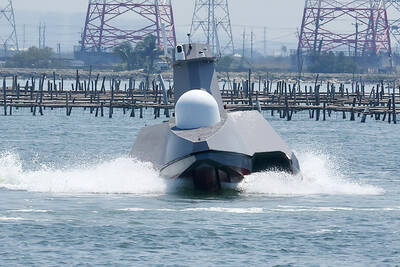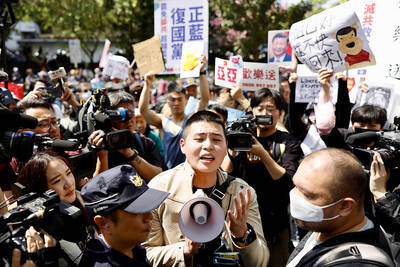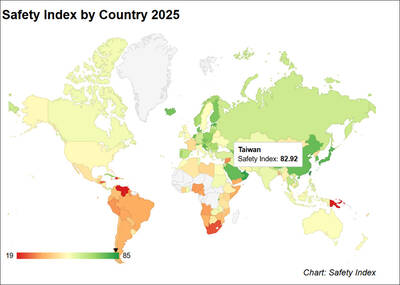A new Pentagon report on the Chinese military concludes that Beijing is rapidly expanding its armed forces “to deter, delay or deny” any possible US support for Taiwan in case of a conflict.
The report warns that despite the efforts of President Ma Ying-jeou (馬英九) to increase economic and cultural ties, China’s military buildup continues unabated.
“The balance of cross-strait military forces continues to shift in [China’s] favor,” the report says.
The long-awaited analysis, which comes about six months after its promised delivery date, paints a grim picture at a time when US-China relations are already strained over problems with North Korea and Beijing’s disputed territorial claims in the South China Sea.
Titled Annual Report on Security Developments Involving China, the 74-page document says China’s military growth and plans remain largely a mystery to the US.
At the same time, Beijing’s continued refusal to reveal its military’s intentions “increases the potential for misunderstanding and miscalculation,” the report says.
“Extreme secrecy is increasingly difficult to reconcile with China’s role in the integrated global economy, which depends on transparency,” it says.
“Despite a reduction in tensions ... the possibility of a military conflict with Taiwan and US military intervention remain the PLA’s [People’s Liberation Army] most pressing long-term military concerns,” the report says.
“A potential cross-strait conflict will drive China’s military modernization as long as China’s leaders judge that the permanent loss of Taiwan could seriously undermine the regime’s political legitimacy and hold on power,” it says. “As part of its planning for a Taiwan contingency, China continues to develop measures to deter or counter third-party intervention, including by the United States, in any future cross-strait crisis.”
“China’s approach to dealing with this challenge is manifest in a sustained effort to develop the capability to attack, at long ranges, military forces that might deploy or operate within the western Pacific,” the report says.
Beijing’s strategy toward Taiwan, the report says, incorporates “elements of persuasion and coercion” to deter or repress the development of political attitudes in Taiwan favoring independence.
“The PLA has developed and deployed military capabilities to coerce Taiwan or to attempt an invasion if necessary,” it says.
However, Beijing, it adds, appears prepared to defer the use of force as long as it believes that long-term reunification remains possible and the costs of conflict outweigh the benefits.
“The PLA is capable of increasingly sophisticated military action against Taiwan,” the report says.
“Some analysts hold that Beijing would first pursue a measured approach characterized by signaling its readiness to use force, followed by a deliberate buildup of force to optimize the speed of engagement over strategic deception,” it says.
“Others contend that it is more likely that Beijing would sacrifice preparations in favor of surprise to force rapid military and or political resolution before other countries could respond,” the report adds.
As of December last year, the PLA had deployed between 1,050 and 1,150 CSS-6 and CSS-7 short-range ballistic missiles to units opposite Taiwan, and has since upgraded the lethality of this force by introducing variants of these missiles with improved ranges, accuracies and payloads, the report says.
The report says that China bases 490 combat aircraft within unrefueled operational range of Taiwan and has the airfield capacity to expand that number by hundreds.
In addition, the PLA has about 1.25 million personnel in its ground forces, with about 400,000 based opposite Taiwan.
While the report says that US President Barack Obama has agreed to sell Taiwan US$6.4 billion in defensive arms, it makes no mention of Taipei’s request to buy 66 advanced new F-16C/D fighters.
If it did come to attack, the report predicts that China would be unable to enforce a full maritime blockade, although its ability to do so will improve “significantly” over the next five to 10 years.
Beijing might use a variety of disruptive, punitive or lethal military actions, the report speculates, to “induce fear in Taiwan and degrade the populace’s confidence in the Taiwan leadership.”
Or, there could be limited air and missile attacks and precision strikes against air defense systems, again conducted to degrade Taiwan’s defenses, neutralize the Taiwanese leadership and break people’s will to fight.
The report says that a large-scale amphibious invasion is unlikely because it would be a “significant political and military risk.”
However, the PLA is capable of accomplishing various amphibious operations short of a full-scale invasion.
“With few overt military preparations beyond routine training, China could launch an invasion of small Taiwan-held islands, such as the Pratas or Itu Aba. A PLA invasion of a medium-sized, defended offshore island such as Mazu [Matsu] or Jinmen [Kinmen] is within China’s capabilities,” the report says.
“Such an invasion would demonstrate military capability and political resolve, while achieving tangible territorial gain and simultaneously showing some measure of restraint,” it says.
“However, this kind of operation includes significant, if not prohibitive, political risk because it could galvanize the Taiwan populace and generate international opposition,” the report says.
Reacting to the report, the Ministry of National Defense urged the US to sell Taiwan advanced weapons systems.
The comments by ministry spokesman Yu Sy-tue (虞思祖) were a reminder to the Obama administration of its obligation to provide Taiwan with the means to defend itself against a possible Chinese attack.
In his comments to reporters, Yu called on the US to sell Taiwan F-16C/D fighter jets and diesel submarines, two systems that have been at the top of its military wish list for most of this decade.
He also acknowledged that despite Ma’s efforts to improve ties with Beijing: “China has never given up the possibility to use force against Taiwan.”
ADDITIONAL REPORTING BY AP

ENDEAVOR MANTA: The ship is programmed to automatically return to its designated home port and would self-destruct if seized by another party The Endeavor Manta, Taiwan’s first military-specification uncrewed surface vehicle (USV) tailor-made to operate in the Taiwan Strait in a bid to bolster the nation’s asymmetric combat capabilities made its first appearance at Kaohsiung’s Singda Harbor yesterday. Taking inspiration from Ukraine’s navy, which is using USVs to force Russia’s Black Sea fleet to take shelter within its own ports, CSBC Taiwan (台灣國際造船) established a research and development unit on USVs last year, CSBC chairman Huang Cheng-hung (黃正弘) said. With the exception of the satellite guidance system and the outboard motors — which were purchased from foreign companies that were not affiliated with Chinese-funded

PERMIT REVOKED: The influencer at a news conference said the National Immigration Agency was infringing on human rights and persecuting Chinese spouses Chinese influencer “Yaya in Taiwan” (亞亞在台灣) yesterday evening voluntarily left Taiwan, despite saying yesterday morning that she had “no intention” of leaving after her residence permit was revoked over her comments on Taiwan being “unified” with China by military force. The Ministry of the Interior yesterday had said that it could forcibly deport the influencer at midnight, but was considering taking a more flexible approach and beginning procedures this morning. The influencer, whose given name is Liu Zhenya (劉振亞), departed on a 8:45pm flight from Taipei International Airport (Songshan airport) to Fuzhou, China. Liu held a news conference at the airport at 7pm,

Taiwan was ranked the fourth-safest country in the world with a score of 82.9, trailing only Andorra, the United Arab Emirates and Qatar in Numbeo’s Safety Index by Country report. Taiwan’s score improved by 0.1 points compared with last year’s mid-year report, which had Taiwan fourth with a score of 82.8. However, both scores were lower than in last year’s first review, when Taiwan scored 83.3, and are a long way from when Taiwan was named the second-safest country in the world in 2021, scoring 84.8. Taiwan ranked higher than Singapore in ninth with a score of 77.4 and Japan in 10th with

Authorities yesterday elaborated on the rules governing Employment Gold Cards after a US cardholder was barred from entering Taiwan for six years after working without a permit during a 2023 visit. American YouTuber LeLe Farley was barred after already being approved for an Employment Gold Card, he said in a video published on his channel on Saturday. Farley, who has more than 420,000 subscribers on his YouTube channel, was approved for his Gold Card last month, but was told at a check-in counter at the Los Angeles International Airport that he could not enter Taiwan. That was because he previously participated in two